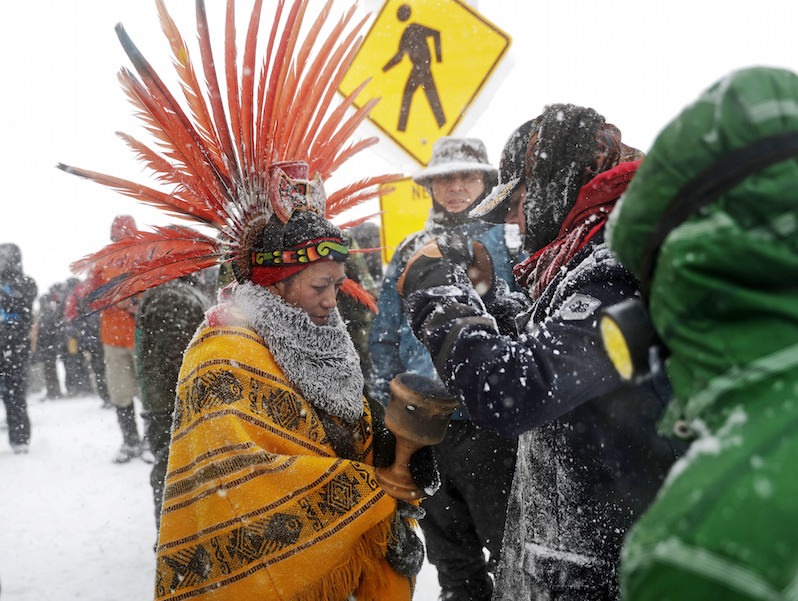Indigenous Resistance Just Might Save Us All
Almost 400 years since the first, mythic Thanksgiving, indigenous people are at the forefront of the fight against catastrophic climate change. Standing Rock water protectors endured harsh winter conditions in Cannon Ball, N.D., to oppose the Dakota Access oil pipeline. (David Goldman / AP)
Standing Rock water protectors endured harsh winter conditions in Cannon Ball, N.D., to oppose the Dakota Access oil pipeline. (David Goldman / AP)
Thanksgiving is one of the great foundational myths of the United States, turning a single gathering of indigenous people in Massachusetts with English settler colonists in 1621 into one of the greatest whitewashes of genocide in world history. Even by that time, native people throughout the Western hemisphere had already suffered horrific violence for over a century, at the hands of Christopher Columbus and other European explorers intent on enslaving native people and exploiting the region’s vast resources. Thanksgiving has morphed into an event celebrating family, feasting and football, a day off before the commercial onslaught of holiday shopping (although the “Black Friday” sales frenzy has intruded on Thanksgiving Day as well). On this Thanksgiving holiday, we should reflect on our true history, and on the remarkable, ongoing indigenous resistance to colonization.
Not long after that mythic first Thanksgiving, colonists flocked to New England, numbering over 1,000 in 1630 and more than 10,000 by 1640. Rapacious demand for land and resources led to The Pequot War in 1636, when hundreds of native people were massacred by colonial militias, followed by King Philip’s War in 1675, when an estimated 3,000 native people were killed.
One of the earliest proclamations defining the holiday of Thanksgiving, made by Massachusetts Bay Governor William Dummer in 1723, thanked God for allowing them “to Defeat in some Measure the repeated Attempts of the Indian Enemy against us, and to defend so many of our frontier Plantations from their Rage & Fury.” Similar racist language appeared just over 50 years later, in the Declaration of Independence, condemning “the merciless Indian Savages.”
The genocide proceeded, from the forced displacement of Cherokee and other native nations in what is remembered as the Trail of Tears, to the relentless westward expansion under the racist Manifest Destiny doctrine, the imposition of the reservation system, followed by Indian boarding schools that separated native children from their families, forbidding them from speaking their native languages and forcing assimilation, often under criminally abusive conditions. Treaties were made by successive presidents and always broken. As Oglala Lakota leader Red Cloud said, “They made us many promises, more than I can remember, but they kept only one; they promised to take our land, and they did.”
In the fall of 1969, a group of Native American activists occupied the abandoned federal prison on Alcatraz Island in San Francisco Bay. Their manifesto used sarcasm, demanding the federal government hand over Alcatraz because it possessed all the qualities of a Native American reservation:
“1. It is isolated from modern facilities, and without adequate means of transportation. “2. It has no fresh running water. “3. It has inadequate sanitation facilities. “4. There are no oil or mineral rights. “5. There is no industry and so unemployment is very great. “6. There are no health-care facilities. “7. The soil is rocky and nonproductive, and the land does not support game. “8. There are no educational facilities. “9. The population has always exceeded the land base. “10. The population has always been held as prisoners and kept dependent upon others.”
The 19-month occupation involved thousands of people and inspired indigenous people across North America to demand justice. The American Indian Movement was founded, leading to the 1973 activist occupation of the town of Wounded Knee on the Pine Ridge Reservation in South Dakota, galvanizing international solidarity for indigenous rights.
On Thanksgiving Day 1970, members of the Wampanoag tribe organized the first National Day of Mourning in Plymouth, Massachusetts, with a march, vigil and fast. The event now nears its 50th anniversary, as “a day of remembrance and spiritual connection as well as a protest of the racism and oppression which Native Americans continue to experience.”
The youth of that era, now elders, joined thousands of indigenous young water protectors at the Standing Rock Sioux Reservation in North Dakota in 2016, to oppose construction of the Dakota Access Pipeline. Among those young activists was historian Nick Estes of the Lower Brule Sioux Tribe. Estes, speaking on the Democracy Now! news hour, recalled Thanksgiving 2016:
“We led a prayer march in the Bismarck, North Dakota, mall to bring attention to the Standing Rock struggle during a Black Friday shopping event, which was met by police armed with AR-15s, who then began punching and kicking water protectors who were holding a prayer. It was a really jarring contrast between the past and the present … between the massacre of Pequots in Massachusetts to the contemporary fight against an oil pipeline.”
Now, almost 400 years since that first, mythic Thanksgiving, indigenous people are at the forefront of the fight against catastrophic climate change. For that, we give thanks.
Your support matters…Independent journalism is under threat and overshadowed by heavily funded mainstream media.
You can help level the playing field. Become a member.
Your tax-deductible contribution keeps us digging beneath the headlines to give you thought-provoking, investigative reporting and analysis that unearths what's really happening- without compromise.
Give today to support our courageous, independent journalists.









You need to be a supporter to comment.
There are currently no responses to this article.
Be the first to respond.